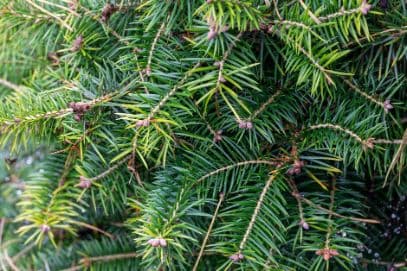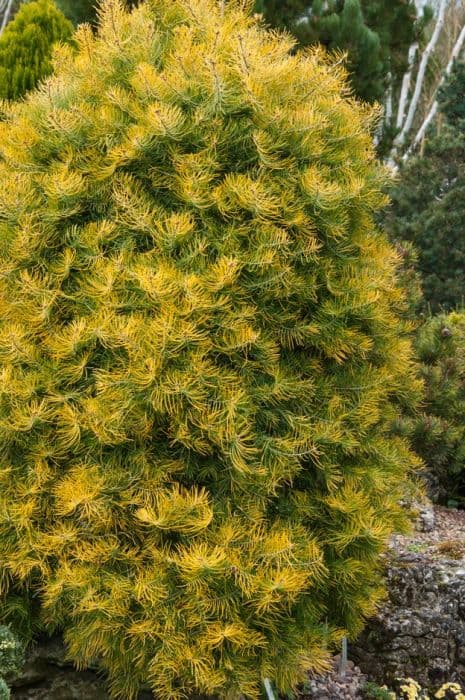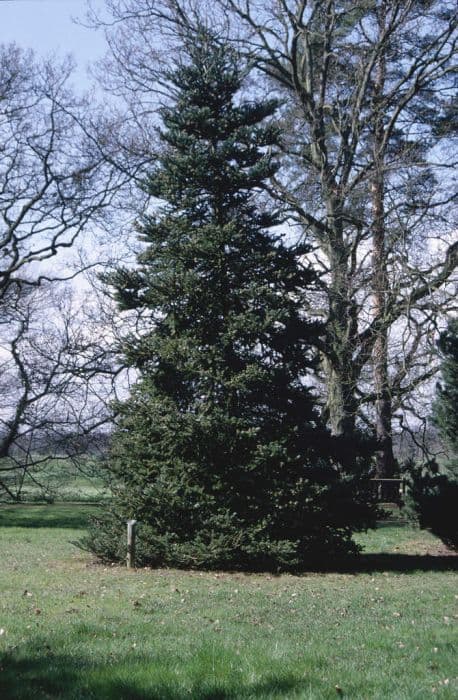Bosnian Pine Pinus heldreichii

ABOUT
The plant commonly known as the Bosnian pine has a distinctive and striking appearance often characterized by its rugged, sturdy nature. This conifer has a conical shape when young, becoming more irregular with age. It features needle-like leaves that are grouped in bundles, presenting a rich, dark green color which can add a touch of boldness to any landscape. The needles themselves are quite long, reaching a substantial length, and are typically stiff to the touch. They are arranged in a spiral manner around the branches, providing a dense and textured look. On the branches, the needles create a visual effect that is both lush and orderly. The bark of the Bosnian pine is another remarkable feature. It is thick and scaly, offering a greyish to silvery-brown hue which can develop deep fissures over time, giving the tree a very robust and textured appearance. The bark's rugged qualities provide an interesting contrast with the smoothness of the needles. As for the cones, they are substantial but not oversized, appearing individually or in small clusters on the branches. These woody cones start out in more subtle shades but mature into a more noticeable brown color, eventually becoming quite woody and hard to the touch. Overall, the Bosnian pine is a resilient and imposing plant possessing a grand visual presence, showing a classic conifer profile with its needle-like leaves and robust bark, all contributing to a quintessential pine appearance. It is a plant that exudes a sense of endurance and can become a dominant feature in any setting where largeness is needed to make a statement.
About this plant
 Names
NamesFamily
Pinaceae
Synonyms
Bosnian Pine, Heldreich's Pine, Greek Pine, Calabrian Pine
Common names
Pinus leucodermis, Pinus heldreichii var. leucodermis
 Toxicity
ToxicityTo humans
Heldreich's pine (Pinus heldreichii) is generally not considered toxic to humans. There are no commonly known toxic effects from ingesting parts of the Heldreich’s pine, and it does not typically pose a risk of poisoning.
To pets
Heldreich's pine (Pinus heldreichii) is also generally considered non-toxic to pets. It is not known to cause poisoning in animals when ingested, so pets that consume parts of this plant are not expected to exhibit toxic symptoms. However, eating non-food items, including plant material, can potentially lead to gastrointestinal upset or blockage, especially in smaller pets.
 Characteristics
CharacteristicsLife cycle
Perennials
Foliage type
Evergreen
Color of leaves
Green
Height
50 feet (15 meters)
Spread
20 feet (6 meters)
Plant type
Tree
Hardiness zones
6
Native area
Balkans
Benefits
 General Benefits
General Benefits- Erosion Control: Pinus heldreichii has a deep root system which helps stabilize soil and prevent erosion.
- Habitat Support: It provides habitat and food for wildlife, such as birds and small mammals.
- Aesthetic Value: With its distinctive shape and evergreen foliage, it's used as an ornamental tree in landscaping.
- Timber Production: The wood is valuable for construction and furniture due to its durability.
- Climate Resilience: It is known for its tolerance to drought and various soil types, making it suitable for reforestation efforts in challenging climates.
- Shade Provider: Its canopy can offer shade, reducing local temperature and providing relief in hot areas.
 Medical Properties
Medical Properties- Antimicrobial: Extracts from Pinus heldreichii may exhibit antimicrobial properties against certain pathogens.
- Antioxidant: The needles of Bosnia pine contain compounds which may have antioxidant effects.
- Anti-inflammatory: Constituents in the resin or extracts of the Bosnia pine might display anti-inflammatory activity.
 Air-purifying Qualities
Air-purifying QualitiesThis plant is not specifically known for air purifying qualities.
 Other Uses
Other Uses- The wood of Pinus heldreichii, also known as the Bosnian pine, is resistant to decay and is utilized in construction, particularly for roofing and flooring where durability is essential.
- Resin extracted from the Bosnian pine can be used in the production of turpentine, which is a solvent for paints and varnishes.
- The slow growth and fine grain of the wood make it suitable for crafting musical instruments, offering good acoustic properties.
- Pine needles of the Bosnian pine may be used in basketry, providing a flexible and sturdy material for weavers.
- Dense growth habit of the Bosnian pine makes it an effective windbreak and shelterbelt species in harsh mountain environments.
- The species has ornamental value and is planted in parks and gardens for aesthetic purposes, especially in xeriscaping due to its drought resistance.
- Bosnian pine cones can be used in decorative arts and crafts, such as making wreaths and other holiday decorations.
- In some cultures, the seeds of the Bosnian pine are roasted and eaten, providing a crunchy snack similar to pine nuts from other species.
- The bark of the Bosnian pine contains tannins and can be utilized in the tanning industry to process leather goods.
- As a symbol of endurance and resilience, the presence of the Bosnian pine in landscaping can be a powerful statement in memorial gardens and monuments.
Interesting Facts
 Feng Shui
Feng ShuiThe Bosnian pine is not used in Feng Shui practice.
 Zodiac Sign Compitability
Zodiac Sign CompitabilityThe Bosnian pine is not used in astrology practice.
 Plant Symbolism
Plant Symbolism- Resilience: Pinus heldreichii, commonly known as the Bosnian Pine, typically grows under harsh conditions, symbolizing the ability to endure and thrive despite difficulties.
- Longevity: The Bosnian Pine can live for hundreds of years, representing endurance through time and symbolizing immortality or the continuation of life.
- Steadfastness: With its sturdy trunk and steadfast growth habit, the Bosnian Pine is a symbol of stability and unwavering strength.
- Wisdom: Ancient trees, like old Bosnian Pines, are often seen as symbols of wisdom and knowledge, having witnessed centuries of history.
- Peace: The evergreen nature of the Bosnian Pine, remaining vibrant throughout the year, can symbolize peace and eternal life.
 Water
WaterThe Bosnian Pine requires minimal watering once established, adapted to withstand dry conditions. This species prefers a deep watering method to saturate the root zone, and it is important not to waterlog the soil, as this can lead to root rot. For young trees, water with approximately 2 gallons once a week during the first growing season to establish a deep root system. After establishment, reduce watering frequency, providing supplemental water only during prolonged dry spells. Mature Bosnian Pines may only need additional watering every two to three weeks, with increased amounts up to 5 gallons if the weather is especially hot and dry.
 Light
LightThe Bosnian Pine thrives in full sunlight and should be planted in a location where it receives at least six hours of direct sunlight daily. This pine does not do well in shaded locations, as inadequate light can lead to sparse foliage and poor growth. The best spot for the Bosnian Pine is an open area away from taller trees or structures that could block its access to sunlight throughout the day.
 Temperature
TemperatureThe Bosnian Pine is hardy and can tolerate a wide range of temperatures, flourishing in conditions between 40 and 70 degrees Fahrenheit. It can survive winter lows down to -30 degrees Fahrenheit and summer highs up to 90 degrees Fahrenheit. However, for optimal growth and health, maintaining an environment where the temperature does not frequently exceed these extremes is ideal.
 Pruning
PruningPruning the Bosnian Pine is generally not necessary, as the tree maintains its shape naturally. However, you may prune to remove dead or damaged branches to maintain its health and appearance. Pruning should occur in late winter to early spring, before the onset of new growth. It is not advisable to extensively cut back living branches, as pines do not recover well from heavy pruning.
 Cleaning
CleaningNot needed
 Soil
SoilThe best soil mix for the Bosnian Pine (Pinus heldreichii) is well-draining, sandy loam with a slightly acidic to neutral pH of 6.0 to 7.5. A mixture of one-third peat moss, one-third sand, and one-third pine bark will provide the appropriate conditions for root growth and health.
 Repotting
RepottingBosnian Pines (Pinus heldreichii) do not require frequent repotting; young trees may be repotted every 2-3 years, while mature trees can go much longer, only needing repotting every 4-5 years or when rootbound.
 Humidity & Misting
Humidity & MistingBosnian Pine (Pinus heldreichii) is adaptable to a wide range of humidity conditions and thrives in outdoor settings where the humidity level is naturally regulated by the environment.
 Suitable locations
Suitable locationsIndoor
Provide bright light, cool temperatures, and air circulation for Bosnian Pine.
Outdoor
Choose a sunny spot, well-draining soil; protect from harsh winds.
Hardiness zone
4-7 USDA
 Life cycle
Life cycleThe life cycle of Pinus heldreichii, commonly known as the Bosnian pine, begins with seed germination following dispersal, often by wind or animals. The seedlings develop a taproot and begin to establish a characteristic pine shape, with a straight stem and symmetrical branches. As the sapling grows, it undergoes a period of vegetative growth, producing needles, branches, and developing a thicker trunk over several years. Sexual maturity is typically reached after 15 to 40 years, when the tree starts to produce cones; male cones release pollen while female cones develop into seed-bearing structures. The Bosnian pine can live for hundreds of years, continuously growing and producing cones annually once maturity is reached, contributing to the forest's regeneration. Finally, as an old-growth tree, it will reach senescence, its growth will slow, and eventually, the tree will die, decompose, and recycle nutrients back into the soil.
 Propogation
PropogationPropogation time
Spring to Summer
The most popular method of propagation for the Pinus heldreichii, commonly known as the Bosnian pine, is through seeds. The best time for seed propagation is autumn, following natural ripening and dispersal from cones. Once collected, seeds should be stratified, which means subjecting them to a period of cold to mimic winter conditions and break seed dormancy. A typical stratification period might last for about 60 to 90 days at temperatures around 35 to 41 degrees Fahrenheit (1.7 to 5 degrees Celsius). After stratification, the seeds are sown in well-draining soil and kept evenly moist. Germination can be slow and sporadic, requiring patience. Seedlings are then grown on in nursery beds or containers until they are sturdy enough to be planted in their permanent location.









